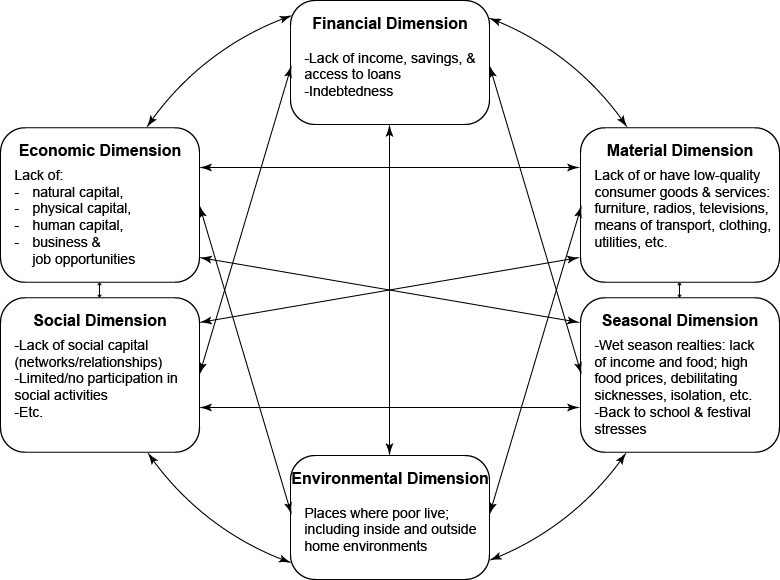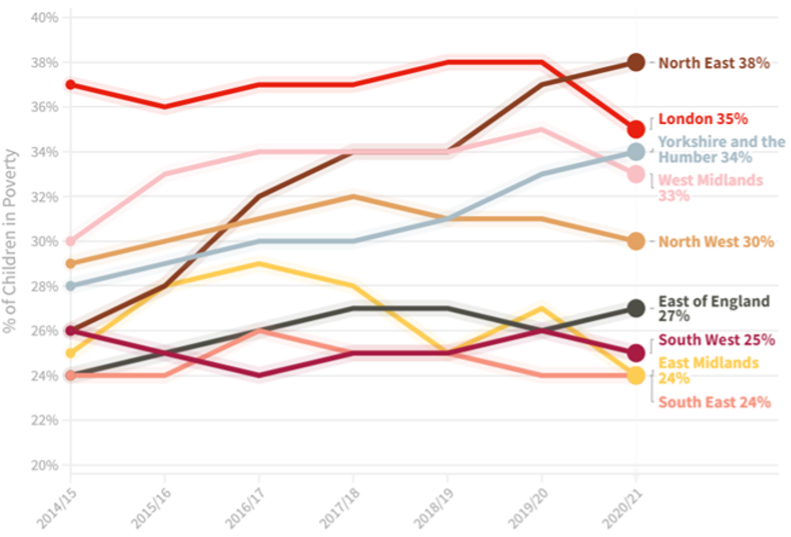Introduction
Poverty is a social issue that affects the overall well-being of the people in the community. In most cases, the facet of poverty is interpreted based on the ability of individuals to afford basic needs such as food, shelter, clothing, and even education. Despite the economic development and growth across the global economies, most people are still not able to meet the minimum living threshold required to be out of poverty. In general, poverty is a state of being unable to afford $2 a day. Proper comprehension of poverty is essential in facilitating the formation of relevant policies to address the social challenge.
Two Different Definitions of Poverty
Poverty has several definitions that have different implications for addressing social issues. It can be referred to as relative or absolute poverty. The various definitions play a significant role in determining the appropriate approaches for interventions.
The Relative Poverty
Relative poverty is perceived from social and economic perspectives. In other words, poverty is not a lack of basic needs but the inability to achieve the overall living standards of the community. It is determined by comparing the individuals’ income to the set income median in the country.
The Absolute Poverty
Absolute poverty is determined based on the fixed standards of basic human needs, including shelter, food, education, and clothing. This facet is mainly used to measure the poverty level in low-income countries. Based on this definition, it is assumed that individuals encountering absolute poverty are unable to afford the mentioned basic requirements.
According to Gweshengwe and Hassan (2020), absolute poverty is measured based on nutrition or income. The authors further define the concept as a situation that deprives society of food, facilitates premature death, high levels of illiteracy, and increases homelessness. If an individual’s income is below the recognized international poverty line of $1.90, it is considered absolute poverty (Gweshengwe & Hassan, 2020). Similarly, Gweshengwe and Hassan (2020) posit that an adult should consume approximately 2500 calories per day, which is considered poverty. Figure 1 below depicts insight into multiple dimensions of poverty.

Different Ways of Measuring Poverty
Generally, measuring poverty is complex, following the variation in definition and understanding of poverty in society. Various conclusions can be drawn when different methods are applied to measure the extent of poverty in the country. The facet is significant in enabling the respective authority to formulate effective and reliable policies that can be used to address the impact of the menace in society. There are three known approaches to measuring poverty, each with unique implications.
The Relative Poverty Line
Based on this measurement approach, the extent of poverty in a country is determined through a percentage of median income in the country where individuals are considered poor. In most cases, the relative poverty line technique is used in nations with high incomes, where the notion of poverty implies other aspects, such as exclusion from social opportunities. The average relative poverty line is mostly approximately 60% of the median earnings in the country (Decerf, 2021). However, the percentage varies significantly from one nation to another.
Relative poverty line measurement techniques imply that they take into consideration both the social and economic aspects of poverty in society. In other words, it portrays that the facet of poverty is not about failing to access the necessities but rather being excluded from social opportunities available in the community (Pu, 2020). Even though this approach is effective, it does not consider some useful aspects, such as the different needs of the people in society.
The Absolute Poverty Line
An absolute poverty line is a measurement approach for fixed standards of human needs such as clothing, food, education, and shelter. When individuals fall below, they are considered to be living in poverty. This criterion applies to low-income nations experiencing cases of limited basic needs. In general, the absolute poverty line is focused on measuring the ability of people to afford healthy living. According to the World Bank, the benchmark of the absolute poverty line is approximately $1.90 per day (Decerf, 2021). In other words, based on the provided figure, any family that is not able to spend more than the stated amount is categorized as living in poverty.
The most significant aspect of this measuring approach is that it provides a clear way of determining the extent of the social issue in society. Furthermore, due to its simplicity, an absolute poverty line can be used to effectively trace the general advancement over a given period. In addition, it can be used to compare the progress in different countries. Another important application of the absolute poverty line is enabling the government to depict the most vulnerable group in society and channel resources to them. Even though the measurement criterion is effective, it fails to consider the cultural and social aspects of poverty.
The Multidimensional Poverty Line
The multidimensional measurement approach is a technique that considers an array of elements. For instance, factors such as social services, education, and healthcare are examined when measuring poverty. In other words, it is beyond the normal income perception. The multidimensional poverty index is the main approach of the mentioned method, mainly used to determine the poverty level based on 10 indicators. The following facets are determined based on the index: Child mortality, access to clean water, nutrition, access to electricity, and years of learning.
The multidimensional poverty line is essential since it covers a wide dimension of poverty. This aspect makes the approach effective for understanding the nature and extent of poverty in society, formulating proper policies, and targeting the right group of people. However, the method requires a large data set to obtain reliable information.

The Extent of Poverty in Contemporary Britain
In contemporary Britain, the issue of poverty remains a complex social issue. Even though Britain is one of the wealthiest nations in the world, a significant number of the population is experiencing hardship in their daily lives. The key indicator of poverty in the UK is income. The country’s median income is 60%, which determines whether or not the family is poor. If a household, including mine, is below the median percentage, then the people are considered to be living in poverty. The current research in the country indicates that many people live below the measurement rate. In the past year, the number has fluctuated following the impact of COVID-19, resulting in loss of employment opportunities and reduced wages.
Poverty is persistent in the UK in areas of housing. There has been a significant increase in temporary houses across the region. This aspect is majorly attributed to the easing cost of houses in the country. The high prices make it challenging for most people to secure affordable houses. Following the fluctuation, the well-being of most individuals is affected.
In addition, in the UK, the aspect of poverty is portrayed in food insecurity. Most people in contemporary Britain face food shortages (Sinha et al., 2020). In other words, individuals cannot afford basic foodstuffs to satisfy their needs. Similarly, the food situation is facilitated by the impact of COVID-19 on the country.
Moreover, contemporary Britain has registered significant cases of child poverty across the country. Large numbers of young ones in the UK are living in extreme poverty, making them unable to afford the necessities for an effective living (Webb et al., 2020). The growing number is facilitated by issues such as the decline in employment and the effects of COVID-19, which has made families with children to be unable to provide for the necessities.
Lastly, the common indicator of poverty in the emerging UK is the growing issue of inequalities caused by factors such as race, disability, gender, and ethnicity. For instance, single women in the country are more likely to experience poverty than men (Robinson, 2019). The same case applies to incapacitated individuals in the country who are at higher risk of poverty (Robinson, 2019). The mentioned conditions usually make it difficult for people to escape the facet of poverty in the UK.
The Sociological Explanation of Poverty
The sociological aspect of poverty encompasses various aspects, such as power relations, social structures, and even cultural beliefs. The facets can be grouped into the following categories;
- Cultural theory perspective.
- Conflict theory viewpoint.
- Structural functionalist.
- Intersectional perspective.
The Cultural Theory Perspective
The cultural theory perspective is focused on how culture influences or shapes poverty in society. Based on this viewpoint, poverty results from factors such as a lack of motivation that allows the social issue to spread across all generations (Sutter et al., 2019). Therefore, it requires people to change their attitudes and beliefs to address the facet of poverty in the community.
Conflict Theory Viewpoint
The aspect of conflict perspective explores factors such as power and inequality in shaping poverty in society. Based on this model, poverty is caused by the unequal distribution of scarce resources and the dominance of a few people with power who control the allocations. It is assumed that poverty is facilitated by the community’s power struggle and inequality practices.
The Structural Functionalist
The structural-functionalist point of view is focused on the role of institutions and social structures in influencing the extent of poverty in society. Based on this sociological aspect, poverty is attributed to unequal opportunities in the community. Significant changes must be applied to the institutions available in society to address the social issue.
Intersectional Perspective
The intersectional viewpoint is focused on the role of social aspects such as gender, race, and class in influencing poverty. Based on this facet, poverty is attributed to social identities that develop a pattern.
Reference List
Decerf, B. (2021). Combining absolute and relative poverty: Income poverty measurement with two poverty lines. Social Choice and Welfare, 56(2), 325–362. Web.
Gweshengwe, B., & Hassan, N. H. (2020). Defining the characteristics of poverty and their implications for poverty analysis. Cogent Social Sciences, 6(1), 1–10. Web.
Pu, X. (2020). Literature review of relative poverty research. Voice of the Publisher, 6(3), 84–90. Web.
Robinson, C. (2019). Energy poverty and gender in England: A spatial perspective. Geoforum, 104, 222-233. Web.
Sinha, I.P. et al. (2020) ‘Child poverty, food insecurity, and respiratory health during the COVID-19 pandemic’, The Lancet Respiratory Medicine, 8(8), pp. 762–763. Web.
Webb, C., Bywaters, P., Scourfield, J., McCartan, C., Bunting, L., Davidson, G., & Morris, K. (2020). Untangling child welfare inequalities and the ‘inverse intervention law’ in England. Children and Youth Services Review, 111(8). Web.